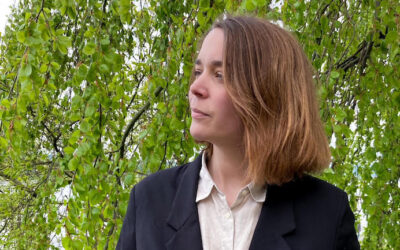The Daylight Award Community
Maiss Razem
MA of Architecture, Virginia Tech University
BA of Architecture Engineering, Jordan University of Science and Technology

FEATURE
What does daylight mean to you?
Reflecting on my architectural education, I tended to marvel at interiors flooded with daylight afforded by expansive areas of glazing. My attitude has altered with time for several reasons. While I still believe that daylight is essential for our wellbeing and physical health, it ought not to be dealt with merely as a required building metric nor regarded as an uncontested aesthetic subject. How daylight is filtered through the materiality of windows and interacted with by building users (prevented, regulated, celebrated) is negotiated against sociocultural and comfort norms. Examining interactions with windows in residential buildings can begin to access how daylight is part of people’s everyday life and how it is linked to the performance of daily domestic practices (cooking, cleaning, waking up, etc.).
Daylight then for me has a sociological dimension whose interpretations should be examined differentially amongst social groups and contexts. Through understanding daylight from users’ perspectives, daylight’s practicality and sensory qualities come to the fore. However, the medium of daylight (materiality of windows) deserves equal attention. A sociological understanding of windows and daylight, hence, can offer deeper insights for architects and building and energy policy makers to re-think design of windows, especially in cases when privacy concerns lead to closing windows and relying on artificial light instead of daylight.
How did your interest in the subject rise?
From living in Jordan, I observed how daylight is underutilized in many houses and apartments. It is a common scene to see windows usually shuttered, especially when they closely overlook neighbouring buildings. Added to that, the use of reflective and tinted windows is prevalent to ensure privacy. Even in villas that have generous glazing areas, users tend to cover them with internal curtains, perhaps for privacy or to moderate the amount of daylight.
From these observations, I increasingly wondered how congruent architectural aesthetic canons are to users’ sociocultural beliefs and habits. What factors led to entrenching certain material choices, like horizontal and coloured windows, in local construction practices? These ponderances also emerged when I practiced and taught architecture, further revealing the deeply lodged and routinized ways of design that leave little space for us to be reflexive or critical. In a later stage of my career after becoming a LEED AP, I also observed that green and sustainable building discourse did not address these issues. Stipulating that windows’ visible transmittance should be more than 0.45 in local codes concerned with energy conservation reflects the importance of daylight but to what extent is it relevant to users’ cultural habits is of no concern. Becoming critical of uncontested use and design of unsustainable glazing materials in local construction, I presented many lectures and led several trainings in Jordan to raise awareness and develop architects’ skills to design better glazing. However, it was only in pursuing a PhD that I seriously wanted to address the social life of windows. Understanding why the current materiality of windows is entrenched in local construction practices and how users interact with the various window affordances (daylight, air, view, solar heating) become an interest that I partially pursued in my PhD in the University of Cambridge, funded by the Islamic Development Bank Cambridge International Scholarship, and supervised by Dr Minna Sunikka-Blank.
How do you work with daylight in your research?
My PhD research is concerned with understanding how cooling energy demand and comfort expectations are socially constructed through material choices that have become normalized in residential buildings in Jordan. One of the materials I investigate is glazing: what aspirations local architects aimed to fulfil when designing windows? What emotional prescriptions were mobilized when glazing was marketed? How were windows interacted with by users, linking to which domestic practices? Each perspective was investigated using different methods, but it was the use of ‘video diaries’ shared by residents recording their routinized interactions with windows that were particularly revealing.
Most of the users were women who not only shared what mattered to them and how they negotiated the utility of windows for many purposes, but also allowed a visual depiction of the material layers that composed domestic windows. Through this, a gendered insight was gained into what daylight meant in the everyday life of women and how it was entangled with other window affordances, cultural norms, and domestic practices. Some of the emergent themes around daylight are captioned next, revealing cases where ‘daylight was too much’, ‘daylight was too little’, ‘daylight is sensory and atmospheric’, ‘daylight serves a practice’, and ‘daylight is obligingly prevented due to privacy’.
All these narratives have implications on escalating or reducing energy demand, which can help guide architects to design houses and windows that are more gender-sensitive, user-centric, and energy-conserving.
Which project/publication describes your work the best?
I have been inspired by the work of scholars investigating the social uses of windows which manifest differentially across contexts and users.
According to you, what is the most important focus for the future?
In my opinion, the most important focus for the future is to critically engage with how daylight is perceived by local people and how such interpretations are consequential not only for policies concerned with energy demand, but policies concerned with enhancing wellbeing and gender equality. Questions emerge from this: how can we re-design window materialities in ways that provide visual and sensory comfort for users who value privacy? How can the design of windows attend to improving women’s daily lives and become integral to performing domestic practices in ways that reduce women’s burdens and reduce energy consumptive habits?

The change in window design and proportions throughout time is fascinating for me. I am particularly inspired by the skills and tacit know-how of master builders from old times, who seemed to have a knack for positioning and partitioning windows in ways that respected the local climate and cultural traditions that value privacy. Born and trained in architecture in Jordan, I am enamoured by reading building facades that incorporate a variety of window elements and colours across time. The image below is for a house in Amman, Jordan, that was built in the early twentieth century that showcases elegant vertical deep windows. Not only do they let in daylight deeper into interior space but evoke intrigue in wondering why windows and shutters were designed in so many parts and how and what motivated users to interact with them in certain ways. Such knowledge may now be hard to access, and I might be romanticizing the past, but it is when examining how contemporary windows, eventually becoming larger, horizontal, and two-dimensional, presumably producing more discomfort to users than comfort (visual, thermal, sensory, etc.), that I reflect on the relevance of presently designed windows to our daily uses.
Following the need to revisit daylight and window design by integrating contextual and sociocultural norms, I really admire Jean Nouvel’s ‘Institut de Monde Arabe’ in the way design of glazing was culturally attentive and not derivative. Expressing modern times, Nouvel reinterprets the traditional element concerned with preserving privacy ‘mashrabiyya’, that used to be dominant in vernacular Arab architecture, in a technologized fashion. It is not only clever aesthetically and conceptually, but it presents an example that inspires and pushes me to always challenge what we as architects have come to accept and take-for-granted as the norm, and how we should do that in a creative way.
Razem, M., & Sunikka-Blank, M. (2022). Selling ‘cool’: The role of marketing in normalizing domestic air-conditioning in Jordan. Energy Research & Social Science, 90, 102582. https://doi.org/10.1016/j.erss.2022.102582
Khalid, R., & Razem, M. (2022). The nexus of gendered practices, energy, and space use: A comparative study of middleclass housing in Pakistan and Jordan. Energy Research & Social Science, 83, 102340. https://doi.org/10.1016/j.erss.2021.102340
Razem, M. (2021). Urban Social Engagement: Social Benefits of Green Infrastructure. GIZ. Link: https://www.giz.de/de/downloads/giz2021-en-social-benefits-of-green-infrastructure.pdf
Razem, M., & Abu Dayyeh, A. (2020). Green buildings in Jordan: Applying LEED to Aqel residence. Self-published. Link: https://www.researchgate.net/publication/345345699_Green_Buildings_in_Jordan_Applying_LEED_to_Aqel_Residence
Razem, M. (2020). Place Attachment and Sustainable Communities. Architecture_MPS. https://doi.org/10.14324/111.444.amps.2020v17i1.003
Abusafieh, S., & Razem, M. (2017). Human Behavior and Environmental Sustainability: Promoting a pro-environmental behavior by harnessing the social, psychological and physical influences of the built environment. E3S Web of Conferences, 23, 02003. https://doi.org/10.1051/e3sconf/20172302003







